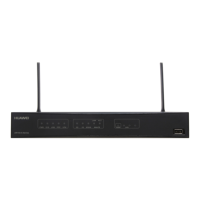Applicable Environment
NAT must be configured at the boundary between the private network and the public network
so that it can translate private and public addresses.
Pre-configuration Tasks
Before configuring NAT, complete the following task:
l Creating a basic ACL or an advanced ACL and configuring ACL rules
Data Preparation
To configure NAT, you need the following data.
No. Data
1 Number of the public address pool, start IP address, and end IP address
2 Number of the basic ACL or advanced ACL
3 Information about the internal server, including the protocol type, public address,
public port number, private address (the VPN instance may be included), and
(optional) private port number
4 Information about static NAT, including the protocol type, public address, public
port number, private address (the VPN instance may be included), (optional)
private port number, and subnet mask
5 Index of the overlapping address pool and temporary address pool, start IP
address, address pool length, and (optional) VPN instance
6 Domain name, public address, and public port number
5.3.2 Configuring an Address Pool
Configure a NAT address pool when multiple users on the private network need to access the
public network.
Procedure
Step 1 Run:
system-view
The system view is displayed.
Step 2 Run:
nat address-group group-index start-address end-address
A public address pool is configured.
A public address pool is a set of public addresses. When performing NAT on data packets from
the private network, the AR150/200 selects an IP address from the address pool as the source
address.
Huawei AR150&200 Series Enterprise Routers
Configuration Guide - IP Service 5 NAT Configuration
Issue 02 (2012-03-30) Huawei Proprietary and Confidential
Copyright © Huawei Technologies Co., Ltd.
110

